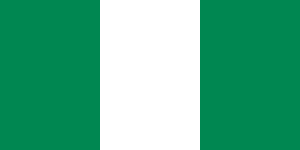Nigerian military juntas of 1966–79 and 1983–99
The Nigerian military juntas of 1966–79 and 1983–99 were a pair of military dictatorships in Nigeria that were led by the Nigerian Armed Forces, having a chairman or president in charge.
| 1966–1979 1983–1999 | |||||||||||||
.svg.png) | |||||||||||||
| Capital | Lagos (1966–1991) Abuja (1991–1999) | ||||||||||||
| Common languages | English · Hausa · Igbo · Yoruba and other regional languages | ||||||||||||
| Religion | Traditional beliefs · Islam · Christianity · | ||||||||||||
| Government | Military dictatorship (de facto) Unitary republic[2][3] (de jure, 1966) Federal republic (de jure, 1966–1999) | ||||||||||||
| President | |||||||||||||
• 1966 | Johnson Aguiyi-Ironsib | ||||||||||||
• 1998–1999 | Abdulsalami Abubakarc | ||||||||||||
| Vice President | |||||||||||||
• 1966 | Babafemi Ogundipe | ||||||||||||
• 1998–1999 | Mike Akhigbe | ||||||||||||
| Historical era | Cold War | ||||||||||||
• Established | 15 January 1966 | ||||||||||||
• Unification Decree[2] | 24 May 1966 | ||||||||||||
| 28 July 1966 | |||||||||||||
• Federal system restored[3] | 31 August 1966 | ||||||||||||
| 30 May 1967 | |||||||||||||
| 30 July 1975 | |||||||||||||
| 13 February 1976 | |||||||||||||
| 1 October 1979 | |||||||||||||
| 31 December 1983 | |||||||||||||
| 27 August 1985 | |||||||||||||
| 17 November 1993 | |||||||||||||
| 29 May 1999 | |||||||||||||
| Area | |||||||||||||
| 1991[4] | 923,768 km2 (356,669 sq mi) | ||||||||||||
| Population | |||||||||||||
• 1991[4] | 88,514,501 | ||||||||||||
| Currency | Nigerian pound (1966–1973) Nigerian naira (1973–1999) | ||||||||||||
| Time zone | UTC+1 (WAT) | ||||||||||||
| Driving side | left (until 2 April 1972)[5] right | ||||||||||||
| ISO 3166 code | NG | ||||||||||||
| |||||||||||||
| Today part of | |||||||||||||
1966 Nigerian coup d'état
Nigeria's first military junta began following the 1966 Nigerian coup d'état which overthrew the First Nigerian Republic. Major General Johnson Aguiyi-Ironsi was made the Head of the Federal Military Government of Nigeria, serving for six months before being overthrown and assassinated in the 1966 Nigerian counter-coup.
First Junta (1966–1979)
Aguiyi-Ironsi was succeeded by General Yakubu Gowon, who established a Supreme Military Council. Gowon held power until July 1975, when he was overthrown in a bloodless coup.
Brigadier (later General) Murtala Mohammed succeeded Gowon. Months later, in February 1976, Mohammed was assassinated by Buka Suka Dimka and others in a violent coup attempt, but the plotters failed to kill Olusẹgun Ọbasanjọ, who then succeeded Mohammed as head of state.
The Supreme Military Council was formally dissolved when Ọbasanjọ handed power to the elected Shehu Shagari, ending the military regime and establishing a Nigerian Second Republic.
Second Junta (1983–1985)
Shagari was overthrown in the 1983 Nigerian coup d'état and succeeded by Muhammadu Buhari, who was appointed Chairman of a new Supreme Military Council of Nigeria and Commander-in-Chief of the Armed Forces by the junta. Buhari ruled for two years, until the 1985 Nigerian coup d'état, when he was overthrown by General Ibrahim Babangida.
Third Junta (1985–1993)
General Ibrahim Babangida promulgated himself as the President of the Armed Forces Ruling Council and the first military President of Nigeria. His rule was the longest serving in peacetime and his administration typified the military dictatorships of the 20th century.
Babangida promised a return of democracy when he seized power, but he ruled Nigeria for eight years, when he temporarily handed power to the interim head of state Ernest Shonekan in 1993 in a move towards democratization. Two months later, however, Shonekan was overthrown by General Sani Abacha while Babangida was visiting Egypt.
Fourth Junta (1993–1999)
In 1993, General Sani Abacha overthrew Interim National Government and appointed himself Chairman of the Provisional Ruling Council of Nigeria. After Abacha's death in 1998, General Abdulsalami Abubakar took over and ruled until Olusẹgun Ọbasanjọ again became head of state (via the 1999 presidential election), ending the junta and establishing the Fourth Nigerian Republic.
See also
- Nigerian First Republic
- Nigerian Second Republic
- Nigerian Third Republic
- Nigerian Fourth Republic
- Politics of Nigeria
References
- Ugorji, Basil (2012). From Cultural Justice to Inter-Ethnic Mediation: A Reflection on the Possibility of Ethno-Religious Mediation in Africa. Outskirts Press. p. 183. ISBN 9781432788353.
- Bah, Abu Bakarr (2005). Breakdown and Reconstitution: Democracy, the Nation-state, and Ethnicity in Nigeria (1st pbk. ed.). Lanham, MD: Lexington Books. p. 108. ISBN 9780739109540.
- Gould, Michael (2011). The Struggle for Modern Nigeria: The Biafran War 1967-1970. I.B.Tauris. p. 116. ISBN 9780857730954.
- Oshungade, I. O. (1995). "The Nigerian Population Statistics" (PDF). 1995 Directory of Nigerian Statisticians. 2: 58. Archived from the original (PDF) on 27 February 2013.
- "Right-Hand/Left-Hand Driving Customs (mostly the change from Left to Right)". rammb.cira.colostate.edu.

